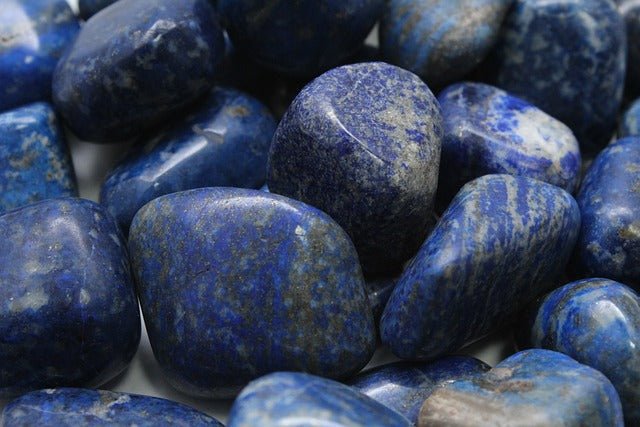
Uncovering the Ancient History of Lapis Lazuli
Share
Lapis lazuli is a stunningly beautiful blue gemstone that has captivated people's imagination for thousands of years. This precious stone has been used for jewelry, amulets, and ornaments since ancient times. It has a long and fascinating history that can be traced back to the earliest civilizations. In this blog post, we will explore the ancient origins of lapis lazuli and its rich history.

Lapis Lazuli contains vibrant blue pigments infused with gold pyrite inlays.
What is Lapis Lazuli?
Lapis lazuli is a blue metamorphic rock that is composed of several minerals, including lazurite, calcite, and pyrite. It is one of the few gemstones that is not a mineral, but rather a rock. The stone has a deep, rich blue color and is often flecked with golden pyrite inclusions. Its color is due to the presence of the mineral lazurite, which is a silicate containing sulfur.

Egyptian bangle bracelet beautifully inlayed with Lapis Lazuli
Ancient Origins
Lapis lazuli has been prized for its beauty and rarity for thousands of years. The ancient Egyptians used lapis lazuli for jewelry, amulets, and even ground it into powder to make the pigment ultramarine, which was used in paintings. In fact, some of the most famous works of art from ancient Egypt, such as the death mask of Tutankhamun, feature lapis lazuli.
The ancient Sumerians also used lapis lazuli for jewelry and amulets, as did the Babylonians and Assyrians. The stone was highly valued in ancient Mesopotamia and was considered to be a symbol of royalty and power.
Lapis lazuli was also used in ancient China, where it was called "heavenly stone." It was highly prized by the Chinese imperial court and was used to make jewelry, vases, and other decorative objects. The stone was also believed to have healing properties and was used in traditional Chinese medicine.
In the ancient world, lapis lazuli was one of the most valuable and sought-after gemstones. It was traded across vast distances, and archaeological finds have revealed that it was used in jewelry and other luxury goods in ancient Greece and Rome.

The golden burial mask of King Tutankhamun, featuring prominent use of Lapis Lazuli
Symbolism and Significance
Lapis lazuli has been associated with royalty, power, and wisdom throughout history. It was often used to decorate the thrones and crowns of rulers, and was believed to have the power to ward off evil and bring good luck.
In ancient Egypt, lapis lazuli was associated with the goddess Isis, who was the patron of magic and healing. The stone was believed to have healing properties and was used in amulets and talismans to promote good health.
In medieval Europe, lapis lazuli was believed to have magical properties and was used by alchemists in their experiments. It was also used in Christian art as a symbol of the heavens and the divine.

Lapis Lazuli has been treasured for thousands of years all over the globe
Conclusion
Lapis lazuli is a truly remarkable gemstone with a rich and fascinating history. Its deep blue color and golden flecks have captivated people's imagination for thousands of years, and it has been prized for its beauty and rarity by cultures around the world. From ancient Egypt to medieval Europe, lapis lazuli has played a significant role in the art, religion, and culture of many civilizations. Today, it remains a highly prized gemstone and is used in jewelry, decorative objects, and even in modern medicine.
